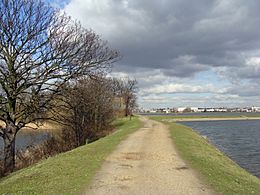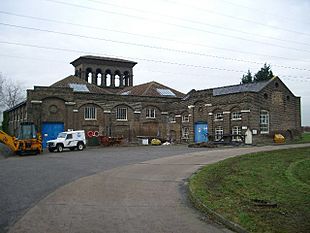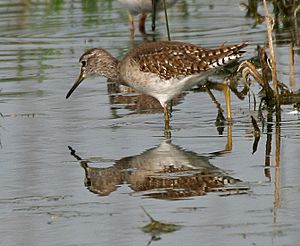Walthamstow Wetlands facts for kids
| Site of Special Scientific Interest | |
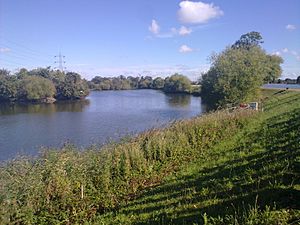 |
|
| Area of Search | Greater London |
|---|---|
| Coordinates | 51°35′11″N 0°03′08″W / 51.586350°N 0.052353°W |
| Interest | Biological |
| Area | 211 hectares (520 acres) |
| Location map | Magic Map |
Walthamstow Wetlands is a 211 ha (520 acres; 2.11 km2) nature reserve in Walthamstow, east London, adjacent to the historic Essex-Middlesex border on the River Lea. It is focused on the Walthamstow Reservoirs, built by the East London Waterworks Company between 1853 and 1904 as part of the Lee Valley Reservoir Chain. The site is one of the largest urban wetland nature reserves in Europe, and is particularly important for wildlife due to its position within the Lee Valley; a byway for migrating, wintering and breeding birds. Visitors can freely access the site's natural, industrial and social heritage in one of the capital's most densely populated urban areas.
The reservoirs, under the ownership of Thames Water, also form part of a larger Site of Metropolitan Importance for Nature Conservation, noted for the mixture of aquatic and terrestrial habitats on site, and for their London-wide importance (especially for birds).
Contents
Setting
The Wetlands, and the rest of the Lee Valley Reservoir Chain are part of the Lee Valley Park, an area stretching from Ware in Hertfordshire (9 miles north of London) to the confluence of the Lea and Thames at Blackwall.
The part of the Lee Valley Park within London forms a green wedge, a mile wide at its broadest at the Walthamstow Wetlands, which extends south to include the Queen Elizabeth Olympic Park. South of Stratford the green wedge becomes little more than an accessible towpath along the Lea which links a number of open spaces.
History
The Walthamstow reservoirs were built on marshland adjoining the River Lea over fifty years between 1853 and 1904 by the East London Waterworks Company, growing in scale and height as the needs of London grew. The company was one of eight private water companies in London absorbed by the Metropolitan Water Board in 1904, which was subsequently abolished in 1974. Control was then transferred to the Thames Water Authority, now Thames Water.
There are two significant Victorian industrial buildings still standing on the site, the Coppermill and the Marine Engine House.
Several of the reservoirs were damaged during the Blitz, and the level of the (raised) Lockwood Reservoir was lowered in order to mitigate potential damage if its banks were breached by bombs.
Historically the reservoirs were used and maintained purely as an element in the supply of water to London's homes, businesses and industries, but in recent decades, the site has been justifiably recognised for its ecological, landscape and amenity value.
Walthamstow Reservoirs
| Site of Special Scientific Interest | |
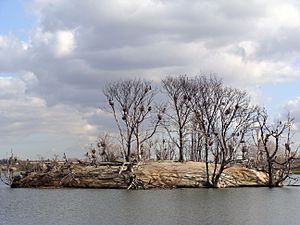
Cormorant Island
|
|
| Area of Search | Greater London |
|---|---|
| Interest | Biological |
| Area | 178.3 hectares |
| Notification | 1986 |
| Location map | Magic Map |
The Walthamstow Reservoirs complex is a mix of statutory (raised) reservoirs and non-statutory (in ground) reservoirs, owned and managed by Thames Water in order to supply drinking water to London.
The complex comprises ten water bodies:
- Lockwood Reservoir
- High Maynard Reservoir
- Low Maynard Reservoir
- East Warwick Reservoir
- West Warwick Reservoir
- Reservoirs 1, 2, 3, 4 and 5
Nature Reserve
Establishment and management
The reservoirs have been developed as a public nature reserve, the Walthamstow Wetlands project, by London Wildlife Trust, in partnership with Thames Water and London Borough of Waltham Forest. The site opened to the public in October 2017.
The Walthamstow Wetlands project is managed by London Wildlife Trust, in partnership with Thames Water and London Borough of Waltham Forest. The project was made possible after the Heritage Lottery Fund provided £4.4 million in funding. In total Walthamstow Wetlands has a value of £8m from capital works and revenue funding over five years, with Thames Water committing £1.84m to the project.
The Greater London Authority have also funded the Wetlands to Wetlands Greenway, improving the 3 km (1.9 mi) cycle links between Woodberry Wetlands in Manor House and Walthamstow Wetlands to encourage visitors to visit both sites.
Designations
The nature reserve is a Site of Special Scientific Interest (SSSI) on account of the reservoirs' national and international importance to breeding, migratory and wintering waterbirds. It is part of a larger Site of Metropolitan Importance for Nature Conservation.
The Coppermill building is a Grade II listed building.
Architecture
There are two Victorian industrial structures on the site, including the Coppermill which gives its name to nearby Coppermill Lane, Coppermill Stream, and the Coppermills Water Treatment Works.
The Marine Engine House
Constructed in 1894, the Marine Engine House, previously named the Ferry Lane Pumping Station, was built during the development of the reservoir complex.
The structure is relatively complex in form, but consists primarily of a two-storey building with a single storey building attached to its northern side. To the west of this is a further single storey building which includes, on its western side, the base of a now-demolished chimney stack. The Marine Engine House is constructed throughout in brick and architecturally is in the simplified Italianate style much used for Victorian industrial buildings, with semi-circular heads to all of the principal door and window openings.
Roofs are generally finished in plain clay tiles with extensive use of patent glazed roof-lights and ridge lights in the single storey sections. The roof of the Engine House is pitched at around 45 degrees, and is half-hipped at its northern and southern ends. Doors and window frames are in painted softwood. Despite the missing chimney, and some external alterations, the building is still an imposing piece of Victorian industrial architecture. The Marine Engine House is to be repaired and refurbished with further plans for it to become an education and learning centre for visitors to the reserve.
The proposal is that it will house:
- Interpretation material on the site's natural and industrial heritage and amenities
- A multi-functional educational space, created for use as a classroom and as a venue for seminars and events
- A ‘Water and Life’ exhibition
- A central lobby area containing a reception and information resource
- A café with capacity to spill out onto an outdoor decked area;
- Toilet facilities
- A modest retail outlet
The Coppermill
The Coppermill building is Grade II Listed and has undergone a number of alterations over the centuries, including the addition of an Italianate tower in 1864. The mill at Walthamstow has been mentioned several times throughout historical records. It was noted that in the 14th century, the mill was powered by the Coppermill Stream that diverted from the River Lea for use in grinding corn. In 1611, four mills are mentioned in association with the Manor of Walthamstow.
From 1659 until 1703, the mill was known to have been used as a paper mill with the adjacent stream being referred to as the Paper-mill River. However, in 1699 the adjacent marshes are noted to have been referred to as Powder Mill Marsh which questions the use of the mill and suggests that it may have been used in the production of gunpowder for the English Civil War between 1642 and 1651. A number of gunpowder mills operated in the Lower Lee Valley, suggesting that the mill may have been used as such during this time.
Accounts from 1703, 1710, 1712 and 1718 record the mill being used as a leather mill, with Pierre Montier, a skin-dresser, first referred to as ‘the Miller’ in 1703 to be followed in turn by Peter Lefevre in 1711 and Daniel Lefevre in 1713.
The mill was noted as an ‘oyl mill’ until 1806 when it was rebuilt and put up for sale. In 1859 the mill was acquired for £4,000 by the East London Waterworks Company, which repurposed it as a pumping house. At present, the Coppermill serves as an operational hub for Thames Water
Ecology
The Walthamstow Reservoirs support the most notable variety of breeding wetland birds among all of London's drinking water reservoirs.
Supporting a significant wintering population of pochard, shoveler and gadwall, Walthamstow Wetlands is regionally important to breeding populations of grey heron, tufted duck, little egret, cormorant and other waterfowl. Because of its location in the Lee Valley, Walthamstow Wetlands attracts a range of wading birds that stop off during their often long-distance journeys.
The wooded islands on No. 1 reservoir are the location of the famous heronry, at which the numbers of breeding pairs reach a level placing it in the country's top five sites. Formerly also a heronry, the two islands in No. 5 reservoir are now home to large numbers of cormorants. Great crested grebe, pochard, tufted duck, coot, yellow wagtail, sedge warbler and reed warbler are all regular breeding visitors, whilst other regular visitors to the reservoirs include green sandpiper, common sandpiper, dunlin, redshank and lapwing, while less common species include ringed plover, little ringed plover, curlew, ruff, snipe, oystercatcher, wood sandpiper, whimbrel, golden plover and little stint.
Zebra mussels, native to southern Russia and Ukraine, have become naturalised in the reservoirs and present an ongoing challenge to the water companies, as over time, their colonies can build up and cause blockages to the pipes leading from the reservoirs.
Nearly 300 species of plant have been recorded in the wooded areas, grass banks, fen and open water habitats of the reservoirs.
Recreation
The ten reservoirs, grounds and the Coppermill Stream form an extensive enclave of natural habitats, albeit within a man made and securely fenced infrastructure. They are visited by birdwatchers and naturalists but especially by anglers. All the reservoirs are variously stocked with fish, providing both coarse fishing and fly fishing. Carp over 40 pounds have been recorded, and rainbow trout up to 5 pounds. An inexpensive day permit is required to visit the site.



